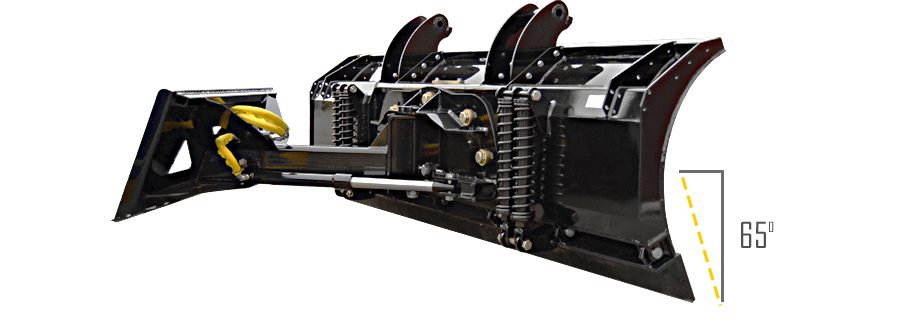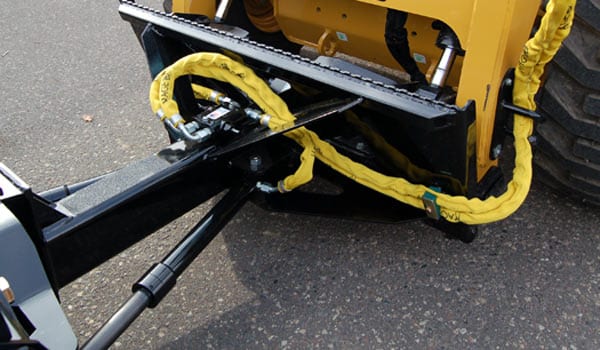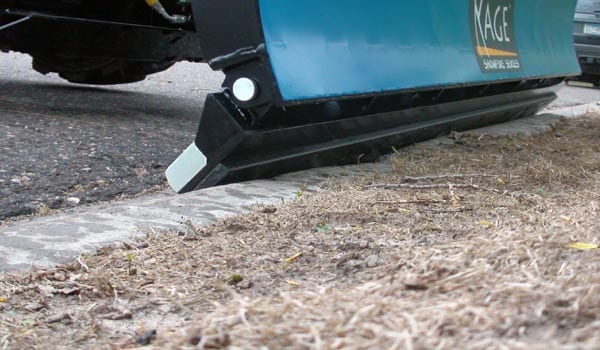
This story is fundamentally true, and happened to us when we just started snow plowing with skid steers. The following story resulted because we had the local fab shop make some skid steer snow plows for us from some brand new ‘pickup truck’ V blades. Being that there weren’t any good solutions for heavy duty skid steer plows yet, this was the next best thing. The V’s had a trip edge so that you could apply down pressure. The custom mount we had made was attached to the plow pivot, and provided a way to attach the plow to the skid steer. The mount also provided some oscillation (side float necessary for skid steer applications), and had a hydraulic cushion accumulator to prevent extreme pressure when hitting obstacles. This all sounded good until you actually put it into use.
“My snow plow fell off” are the shaky words that you hear over the phone at 1:30 am as you hurriedly take off your gloves to answer the call. “WHAT??!” is your reply. “Yup, the plow keeps coming off at the attachment plate. It’s happened a few times already and this last time it happened as I was back dragging and now the hoses ripped out too!”
This is gut-wrenching news when you are a 5-6 man operation and this skid steer and plow is the only piece of equipment you have capable of clearing the site it’s on. You are the owner, and now it’s up to you to make a decision. You feel the wind whipping down the collar of your jacket, and you realize that the glove you ripped off in order to answer the phone call is still in your mouth, and now your teeth are clenched around it as your blood pressure rises. You grab the shovel you were using on the dimly lit store front sidewalk, and trudge back over to your pickup, stabilizing yourself from the icy walk along the way.
Reaching your truck you start the engine and climb into the cab, pulling the door shut hard against the wind. “Joe, I need you to tell me what happened.” Joe says “I don’t know, boss, the plow keeps falling off, 2 or three times, and now the hoses are pulled apart and there’s a puddle of fluid over there in the snow. The machine still works but I’ve nothing to plow with.”
7 Break Points To Look For When Buying A Skid Steer Snow Plow
Here are some buying tips when you are looking for a skid steer snow plow. If you have any questions about the heavy duty KAGE® skid steer plow, email us at info@kageinnovation.com. You want to avoid Joe’s story, and here are the details you need to look carefully at. Don’t be oversold on wing plows, V plows, or anything else that looks prone to failure. They promise the world, but can fail you when your business is on the line.
Attachment Plate
 The attachment plate is what holds the snow plow attachment to your machine. This is probably the most critical part of the snow plow, and also the first part to fail. Snow plowing with a skid steer puts a lot more abuse into the plow attachment than truck plowing. Down pressure, stacking, slamming, and shaking, are all advantages to plowing with a skid steer, but pose the maximum level of abuse to the equipment they are pushing. Look for your attachment plate to be beefy and well designed. It’s especially helpful to have the top lip ½” thick, and gusset reinforcements 9” or so from each side.
The attachment plate is what holds the snow plow attachment to your machine. This is probably the most critical part of the snow plow, and also the first part to fail. Snow plowing with a skid steer puts a lot more abuse into the plow attachment than truck plowing. Down pressure, stacking, slamming, and shaking, are all advantages to plowing with a skid steer, but pose the maximum level of abuse to the equipment they are pushing. Look for your attachment plate to be beefy and well designed. It’s especially helpful to have the top lip ½” thick, and gusset reinforcements 9” or so from each side.
Oscillation
 Side to side float is important, especially for skid steer plowing because the skid steer doesn’t have suspension, and the mounting system is so rigid that the plow will not float with the contours of the pavement unless it has oscillation. Oscillation should be designed in such a way that it operates whether or not the plow is angled.
Side to side float is important, especially for skid steer plowing because the skid steer doesn’t have suspension, and the mounting system is so rigid that the plow will not float with the contours of the pavement unless it has oscillation. Oscillation should be designed in such a way that it operates whether or not the plow is angled.
If the oscillation is placed back by the skid steer attachment, be aware that this is prone to failure. Down pressure exerts tremendous force on the attachment plate area, so oscillation that happens there is just another weakness added to the attachment plate. Preferably the oscillation should happen up by the moldboard itself. Close to the plow pivot. Two grease able sliding plates are preferred.
Trip Edge
 Skid steers are all about putting down pressure to the cutting edge. That is one of the significant benefits when using a skid steer. You can apply down pressure instantly for back dragging, or forward scraping. What you don’t want is your plow to unnecessarily trip over while you are scraping. Trip-edges are the best for skid steer applications because they have a more controlled trip, and if they do trip you won’t loose your entire load of snow.
Skid steers are all about putting down pressure to the cutting edge. That is one of the significant benefits when using a skid steer. You can apply down pressure instantly for back dragging, or forward scraping. What you don’t want is your plow to unnecessarily trip over while you are scraping. Trip-edges are the best for skid steer applications because they have a more controlled trip, and if they do trip you won’t loose your entire load of snow.
The trip edge should be tall enough to clear your common curb, so that when you do hit one, it trips and glides over. The last thing you want is for the edge to trip, but you still end up slamming into the top of the curb with your plow. Curbs here in Minnesota are about 7” tall, so make sure that your skid steer snow plow has a trip edge at least that tall.
Compression Springs
Trip edges utilize a spring mechanism to enable them to flip back after tripping over an obstacle. There are 3 common types of trip edge springs. Compression, extension, and torsion. Look for compression springs because they don’t have the susceptible hook at each end, and they are easy to replace unlike torsion springs.
Attack Angle
Your ability to scrape down to the pavement partially depends upon the attack angle of your cutting edge. If the cutting edge is sloped too gradually, it will skim over the hard pack, and it will take extra down pressure to get underneath. If the cutting edge is too perpendicular, it will not roll the snow properly. You should look for the cutting edge to be about 65° measured from parallel to the ground. This will give you the optimum scraping and rolling capability.
Moldboard Reinforcement
Before we realized the abuse that skid steers put on our snow plows, truck plows with the regular ‘ribbed’ reinforcement seemed fine. Once you start pushing piles back, scraping and stacking, you realize that the thin gauge steel and rib design is just not sturdy enough anymore. Truck plows are not designed for skid steer use. Moldboard reinforcement for the entire length of the moldboard is important, especially when you are talking 9’, or larger. Boxing in the back of the moldboard is very strong opposed to the open ribs common to many cheaper designs.
Paint
Powder coat paint is probably the most common in the industry, and certainly produces the hardest ‘outer shell’. Look at the process that the plow manufacturer uses while finishing the product, as this can make all the difference in adhesion. Sandblasting the surface prior to washing and coating is critical, especially when using a powder coat finish. Sandblasting removes the mill scale, laser scale, dirt, and also creates a small 1-3 mill ‘profile’ which allows the paint to ‘grab’ onto the surface.
Crossover Relief Valve
Every snow plow hydraulic system needs to have some sort of cushion in case of hitting immovable obstacles. This will prevent catastrophic failure to the equipment or machine. One time I was using a plow without a crossover valve, hit a curb hard enough that it blew a steel hydraulic line inside of the machine. This was a costly and time consuming repair. Something that would have been completely avoided if the plow had a crossover relieve valve built into it.
Are you thinking about using skid steers vs. trucks? Check out this previous article we wrote on the advantages that skid steers have over truck plows.

Recent Comments